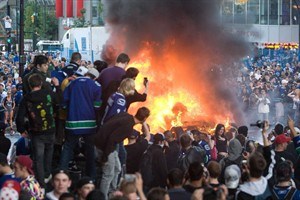
Vancouver Canucks fans watch a car burn during a riot following game 7 of the NHL Stanley Cup final in downtown Vancouver, B.C., on Wednesday, June 15, 2011. It's been a year since the Vancouver Canucks' loss in Game 7 of the Stanley Cup final set off a riot that swept through the city's downtown last June 15, leaving a trail of burnt cars, broken windows and looted storefronts. THE CANADIAN PRESS/Geoff Howe
June 15, 2012 - 4:00 AM
VANCOUVER - Damage done to the psyche of those unwillingly caught up in last year's Stanley Cup riot was the most expensive part of workers compensation claims related to the mayhem.
In total, 24 of 51 filed claims were accepted by WorkSafeBC, the provincial workers compensation agency. Only four of them were for post-traumatic stress disorder, but the awards for those claims consumed $71,000 of the $117,000 in claims incurred in the riot's aftermath.
The Canadian Mental Health Association on its website says PTSD symptoms include flashbacks or nightmares, emotional numbing and withdrawing from friends and family.
A spokeswoman at WorkSafeBC would not provide details about the compensation claims, citing privacy.
But Kerry Jang, a psychiatry professor at the University of British Columbia who is also a Vancouver city councillor, said he was not surprised to learn of the PTSD claims after watching riot footage live on TV.
Jang said he was particularly concerned about those beaten while trying to stop rioters, police who were attacked and terrorized store clerks.
"I was wondering if, for example, the store clerks at London Drugs who had to lock themselves in a room were also suffering from a form of it because they could hear the smashing outside," said Jang.
"Watching the things being described afterwards in the media, it seemed like some pretty PTSD-like symptoms."
Jang said the disorder is most commonly associated with emergency workers and military personnel, but that a situation like a riot could yield sufferers.
"If you feel absolutely threatened, it has a very different cognitive affect," he said. "I'm certainly sure they felt their life was truly threatened in a real, significant way."
Jang said the media storm after the riot could have worsened the symptoms for those suffering if they had been asked by reporters to recount their experience over and over.
During the riot, 18 Vancouver police officers and one firefighter were assaulted. The police department wouldn't say if any of its members had claimed PTSD, also noting privacy concerns.
Other non-PTSD-related claims included concussions, severe bruises, muscle strains, burns and similar physical injuries. Twelve claims were strictly for compensation for health-care costs and did not include time off work.
WorkSafeBC said of the 27 claims that were not accepted, one was rejected and 19 were suspended due to a lack of information.
Seven more claims were either disallowed because they did not happen in the course of work or had no associated costs.
The numbers are a drop in the bucket compared to the usual annual amount of claims WorkSafeBC receives.
In 2011 more than 100,000 claims were filed.
News from © The Canadian Press, 2012